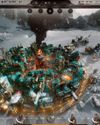
Your country is at war, and you start picking up directional radio signals that sound like nothing you’ve ever heard before. The enemy is highly mechanized, makes use of the latest technology, and has a record of using complex codes and ciphers in its transmissions. This is something new, however. Instead of the dots and dashes of the Morse code you’re used to intercepting, this sounds like a harsh wailing.
These days, we’d probably equate the sound with a 56K modem, but back in the 1940s, it was known as teleprinter code. Nazi high command, not content with the “unbreakable” Enigma cipher it used to spread orders among its companies and brigades, was also using a machine for higher-level communications called the Lorenz SZ that British codebreakers had never seen, and would not see until the end of World War II. Despite this, they were able to deduce how it worked, and crack the encipherment.
This is the story of a country house in England full of mathematicians, crossword enthusiasts, the occasional genius, and a man from the postal service more used to creating automated telephone exchanges. Together, they read German military communications and shortened WWII by up to four years, saved possibly millions of lives, and created Colossus, the first programmable electronic computer, in the process.
Denne historien er fra May 2021-utgaven av Maximum PC.
Start din 7-dagers gratis prøveperiode på Magzter GOLD for å få tilgang til tusenvis av utvalgte premiumhistorier og 9000+ magasiner og aviser.
Allerede abonnent ? Logg på
Denne historien er fra May 2021-utgaven av Maximum PC.
Start din 7-dagers gratis prøveperiode på Magzter GOLD for å få tilgang til tusenvis av utvalgte premiumhistorier og 9000+ magasiner og aviser.
Allerede abonnent? Logg på

Google Gemini vs. ChatGPT
Which LLM currently holds the crown?

Frostpunk 2
Endure a blizzard of tough choices and lasting consequences in the survival city builder sequel

Elgato Facecam Neo
Always sees us in the best light but lacks focus: 8/10 boyfriend, er, camera

Elgato Wave Neo
The Kanye West of mics: Easy to get into, but a little weird

Razer BlackWidow V4 75%
Solid and compact, with hot-swappable switches

Razer Wolverine V3 Pro
Razer's pro controller is even better than Microsoft's

Acer Predator GM712
2008 called, it wants its projector back

AndaSeat Kaiser 4 XL
A chair as big and as comfortable as they come

Gigabyte F027Q2
Speed is of the essence with this OLED screen

Acer Nitro 14
AMD puts on a good show, but it still lacks punch